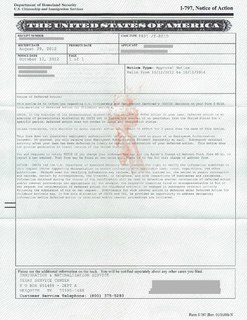
Immigration to the United States is the international movement of non-United States nationals to reside permanently in the country. Immigration has been a major source of population growth and cultural change throughout much of the United States. history. All Americans, except for Native Americans, can trace their ancestry to immigrants from other nations around the world.

The United States had an official resident population of 331,449,281 on April 1, 2020, according to the U.S. Census Bureau. This figure includes the 50 states and the District of Columbia but excludes the population of five unincorporated U.S. territories as well as several minor island possessions. The United States is the third most populous country in the world. The Census Bureau showed a population increase of 0.8% for the twelve-month period ending in July 2012. Though high by industrialized country standards, this is below the world average annual rate of 1.1%. The total fertility rate in the United States estimated for 2020 is 1.638 children per woman, which is below the replacement fertility rate of approximately 2.1.

Hundreds of migrants die per year as they attempt to cross into the United States from Mexico illegally. The US Border Patrol reported 294 migrant deaths in the fiscal year 2017, which was lower than in 2016 (322), and any year during the period 2003–2014. Exposure were the leading cause.

The Immigration Reform and Control Act was passed by the 99th United States Congress and signed into law by U.S. President Ronald Reagan on November 6, 1986.
Illegal immigration to the United States is the process of migrating into the United States in violation of federal immigration laws. This can include foreign nationals (aliens) who have entered the United States unlawfully, as well as those who lawfully entered but then remained after the expiration of their visas, parole, TPS, etc. Illegal immigration has been a matter of intense debate in the United States since the 1980s.
Honduran Americans are Americans or US citizens of Honduran heritage, who belong to one or more ethnic groups such as mestizo, white, Lenca, Ladino people, Miskito people, Garifuna, and Creole peoples. The Honduran population at the 2010 Census was 837,694. Hondurans are the eighth largest Latino group in the United States and the third largest Central American population, after Salvadorans and Guatemalans.

Illegal immigration refers to the migration of people into a country in violation of the immigration laws of that country, or the continued residence without the legal right to live in that country. Illegal immigration tends to be financially upward, from poorer to richer countries. Illegal residence in another country creates the risk of detention, deportation, and/or other sanctions.

Non-Hispanic whites or Non-Latino whites are European Americans, Middle Eastern Americans, and North African Americans as defined by the United States Census Bureau. Americans of European ancestry represent ethnic groups and more than half of the white population are German, Irish, English, Italian and Polish Americans. In the United States, this population was first derived from English settlement of the Americas, as well as settlement by other Europeans such as the Germans and Dutch that began in the 17th century. Continued growth since the early 19th century is attributed to sustained very high birth rates alongside relatively low death rates among settlers and natives alike as well as periodically massive immigration from European countries, especially Germany, Ireland, England, Italy, Greece, the Netherlands, France and Wales, as well as Poland, Russia, and many more countries. It typically refers to an English-speaking American in distinction to Spanish speakers in Mexico and the Southwestern states. In some parts of the country, the term Anglo-American is used to refer to non-Hispanic white English speakers as distinct from Spanish speakers although the term is more frequently used to refer to people of British or English descent and might include white people of Hispanic descent who no longer speak Spanish.

Emigration from Mexico is the movement of people from Mexico to other countries. The top destination by far is the United States, by a factor of over 150 to 1 compared to the second most popular destination, Canada.
There are thought to be over half a million undocumented immigrants residing in New York City. They come from many parts of the world, especially Latin America, Asia, Eastern Europe, and the Caribbean. About 70% of them have paid work, in catering, construction, retail, driving, cleaning, and many other trades; at least in catering, their wages tend to be lower than those of comparable workers.
The economic impact of undocumented immigrants in the United States is challenging to measure, and politically contentious. Research shows that undocumented immigrants increase the size of the U.S. economy/contribute to economic growth, enhance the welfare of natives, contribute more in tax revenue than they collect, reduce American firms' incentives to offshore jobs and import foreign-produced goods, and benefit consumers by reducing the prices of goods and services. Economists estimate that legalization of the undocumented immigrant population would increase the immigrants' earnings and consumption considerably, and increase U.S. gross domestic product.
Second-generation immigrants in the United States are individuals born and raised in the United States who have at least one foreign born parent. Although the term is an oxymoron which is often used ambiguously, this definition is cited by major research centers including the United States Census Bureau and the Pew Research Center.

Deferred Action for Childhood Arrivals (DACA) is a United States immigration policy that allows some individuals with unlawful presence in the United States after being brought to the country as children to receive a renewable two-year period of deferred action from deportation and become eligible for an employment authorization document in the U.S. To be eligible for the program, recipients cannot have felonies or serious misdemeanors on their records. Unlike the proposed DREAM Act, DACA does not provide a path to citizenship for recipients. The policy, an executive branch memorandum, was announced by President Barack Obama on June 15, 2012. U.S. Citizenship and Immigration Services (USCIS) began accepting applications for the program on August 15, 2012.
Undocumented youth in the United States are young people living in the United States without U.S. citizenship or other legal immigration status. An estimated 1.1 million undocumented minors resided in the U.S. as of 2010, making up 16% of the undocumented population of 11 million. Undocumented students face unique legal uncertainties and limitations within the United States educational system. They are sometimes called the 1.5 generation, as they have spent a majority of their lives in the United States.
This article delineates the issue of immigration in different countries.

The 2014 American immigration crisis was a surge in unaccompanied children and women from the Northern Triangle of Central America (NTCA) seeking entrance to the United States in 2014. According to U.S. law, an unaccompanied alien child refers to a person under 18 years of age, who has no lawful immigration status in the U.S., and who does not have a legal guardian to provide physical custody and care.
A considerable portion of the United States' population is foreign-born. Undocumented immigrants make up about 28% of the foreign-born residents. A model analyzing data from 1990-2016 estimates the number of undocumented immigrants in the US range from 16.7 million to 22.1 million.

The Victims of Immigration Crime Engagement (VOICE) Office was a U.S. government agency established within the Department of Homeland Security under the Trump administration in February 2017. President Donald Trump directed it be established by Executive Order 13768. The office was dissolved by the Biden administration on June 11, 2021, replaced by the Victims Engagement and Services Line (VESL).
The issue of crimes committed by illegal immigrants to the United States is a topic that is often asserted and debated in politics and the media when discussing Immigration policy in the United States.











